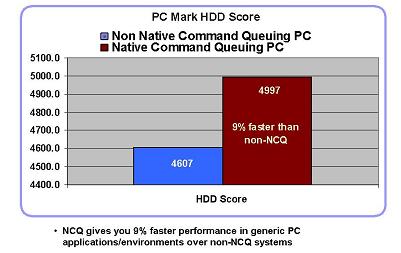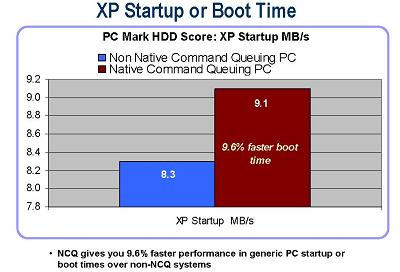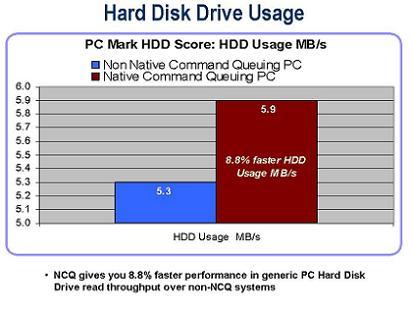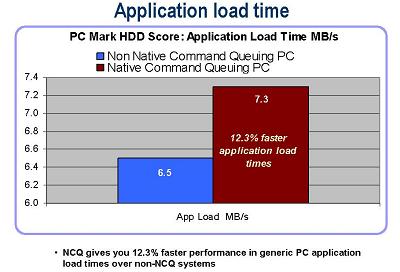Native Command Queuing (NCQ) is a technology designed to improve performance and reliability as the transactional workload increases on SATA hard disk drives. When multiple read and write commands are sent to the SATA drive, NCQ steps in to optimize the completion of these commands by grouping the commands in order of processing efficiency, thereby reducing the mechanical workload and increase performance from the drive. Without NCQ, the drive would process and complete each command one at a time in the order in which it was received.
NCQ Benefits:
- Works in all systems where host controllers support the SATA NCQ feature including desktop PCs, workstations, digital media content servers, entry servers, as well as high performance PCs and mobile/notebook systems
- Provides 100% backward compatibility with non-NCQ supporting systems
- Allows the reordering of commands by the storage device to increase the efficiency of its data transfers
- Improves seek time performance from hard drives and allows solid state drives to access the stored command queue to boost performance
NCQ is a feature that is designed into the Serial ATA interface. To take advantage of NCQ, both the host controller/chipset and hard drive need to support the feature.
The NCQ-enabled hard drive on the left can execute four commands (A, B, C, and D) in a total of one and a quarter complete rotations due to proper ordering of the operations. The non-NCQ hard drive on the right requires a full two and three quarters rotations to execute the same four commands (A, B, C, and D) as a result of poor ordered operations.
NCQ provides higher performance in heavy transactional workloads traditionally found in high performance workstations, network servers, multi-media servers and editing workstations. NCQ also contributes to improved overall system performance in various computing operations including system booting to file copying.
The following graphs illustrate the advantages of NCQ in a system1 across several different use cases.



More information on NCQ is available in the White Paper published by the Serial ATA International Organization (SATA-IO), which governs the SATA interface specification and associated technologies:
Comparing SATA Native Command Queuing (NCQ) and ATA Tagged Command Queuing (TCQ): The Advantage of Serial ATA Native Command Queuing
System Configuration for NCQ PC
Microsoft Windows XP Professional, Version 5.1.2600 Service Pack 2 Build 2600 INTEL D925XCV, Processor 4 Intel 2800 Mhz, BIOS Version/Date Intel Corp.
CV92510A.86A.0316.2004.0929.1610, 9/29/2004 SMBIOS Version 2.3, Boot Device: Seagate Barracuda 7200.7 PATA 160GB, RAM Kingston/vr (KVR533D2N4K2/512) 1,024.00 MB / 4 sticks of 256K memory.
Test drives: Seagate Barracuda 7200.7 with NCQ and Seagate Barracuda 7200.7 without NCQ.
System Configuration for non-NCQ PC
Microsoft Windows XP Professional Version 5.1.2600 Service Pack 2 Build 2600 INTEL D865GBF, Processor Intel 2793 Mhz, BIOS Version/Date Intel Corp.
BF86510A.86A.0046.P10.0309241107, 9/24/2003 SMBIOS Version 2.3, Boot Device: Seagate Barracuda 7200.7 PATA 160GB, RAM
Elixir1,024 MB/4 sticks of 256 DDR-400MHz CL2.5, Test drives: Seagate Barracuda 7200.7 with NCQ and Seagate Barracuda 7200.7 without NCQ
